warning light Citroen DS4 2016 1.G User Guide
[x] Cancel search | Manufacturer: CITROEN, Model Year: 2016, Model line: DS4, Model: Citroen DS4 2016 1.GPages: 436, PDF Size: 10.28 MB
Page 170 of 436

Braking assistance systems
Group of supplementary systems which help
you to obtain optimum braking in complete
safety in emergency situations:
-
a
nti-lock braking system (ABS),
-
e
lectronic brake force distribution (EBFD),
-
e
mergency braking assistance (EBA).Anti-lock braking system
and electronic brake force
distribution
Linked systems which improve the stability and
manoeuvrability of your vehicle when braking,
in particular on poor or slippery sur faces.
Activation
The anti-lock braking system comes into
operation automatically when there is a risk of
wheel lock.
Normal operation of the ABS may make itself
felt by slight vibration of the brake pedal. When braking in an emergency, press
very firmly without releasing the
pressure.
Operating fault
If this warning lamp comes on,
together with the STOP and ABS
warning lamps, accompanied by an
audible signal and a message in the screen, it
indicates a malfunction of the electronic brake
force distribution which could result in loss of
control of the vehicle when braking.
You must stop as soon as it is safe to do so.
When replacing wheels (tyres and
rims), ensure that they conform to the
manufacturer's recommendations.If this warning lamp comes on,
accompanied by an audible signal
and a message in the screen, it
indicates a malfunction of the anti-lock braking
system which could result in loss of control of
the vehicle when braking.
In either case, contact a CITROËN dealer or a
qualified workshop.
Page 176 of 436

The driver must ensure that passengers use
the seat belts correctly and that they are all
restrained securely before setting off.
Wherever you are seated in the vehicle,
always fasten your seat belt, even for short
journeys.
Do not interchange the seat belt buckles as
they will not fulfil their role fully.
The seat belts are fitted with an inertia reel
permitting automatic adjustment of the length
of the strap to your size. The seat belt is
stowed automatically when not in use.
Before and after use, ensure that the seat
belt is reeled in correctly.
The lower part of the strap must be
positioned as low as possible on the pelvis.
The upper part must be positioned in the
hollow of the shoulder.
The inertia reels are fitted with an automatic
locking device which comes into operation in
the event of a collision, emergency braking
or if the vehicle rolls over. You can release
the device by pulling the strap firmly and then
releasing it so that it reels in slightly.Recommendations for
children
Use a suitable child seat if the passenger is
less than 12 years old or shorter than one
and a half metres.
Never use the same seat belt to secure
more than one person.
Never allow a child to travel on your lap.
For more information, refer to the "Child
seats" section.
Advice
In order to be effective, a seat belt must:
- b e tightened as close to the body as
possible,
-
b
e pulled in front of you with a smooth
movement, checking that it does not
twist,
-
b
e used to restrain only one person,
-
n
ot bear any trace of cuts or fraying,
-
n
ot be converted or modified to avoid
affecting its performance.
In accordance with current safety regulations,
for all repairs on your vehicle's seat belts, go
to a qualified workshop with the skills and
equipment needed, which a CITROËN dealer
is able to provide.
Have your seat belts checked regularly by
a CITROËN dealer or a qualified workshop,
particularly if the straps show signs of
damage.
Clean the seat belt straps with soapy water or
a textile cleaning product, sold by CITROËN
dealers.
After folding or moving a seat or rear bench
seat, ensure that the seat belt is positioned
and reeled in correctly.
In the event of an impact
depending on the nature and
seriousness of the impact , the
pretensioning device may be deployed
before and independently of the airbags.
Deployment of the pretensioners is
accompanied by a slight discharge of
harmless smoke and a noise, due to the
activation of the pyrotechnic cartridge
incorporated in the system.
In all cases, the airbag warning lamp
comes on.
Following an impact, have the seat belts
system checked, and if necessary replaced,
by a CITROËN dealer or a qualified
workshop.
Page 187 of 436
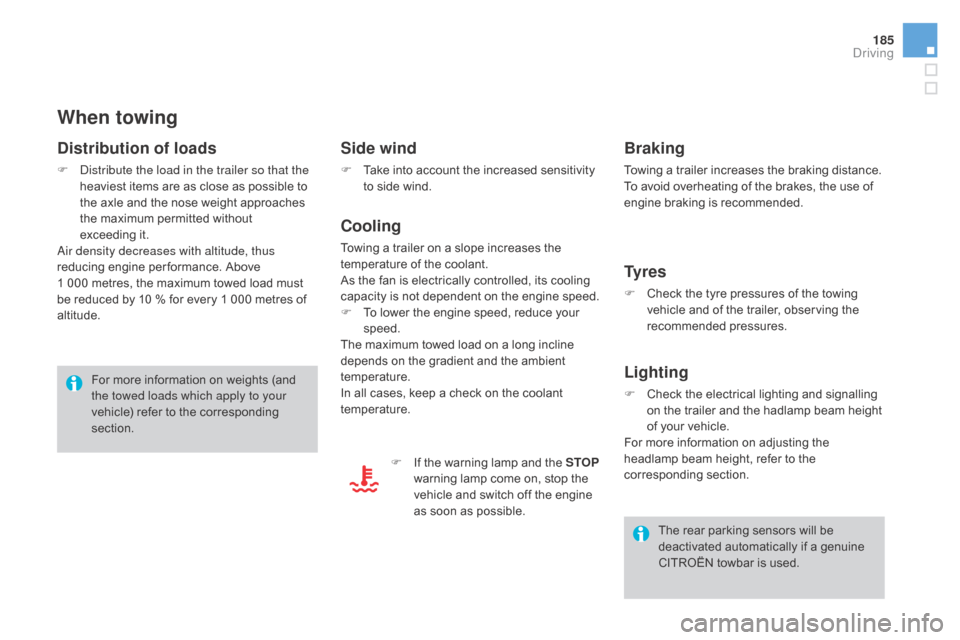
185
DS4_en_Chap08_conduite_ed03-2015
When towing
distribution of loads
F Distribute the load in the trailer so that the heaviest items are as close as possible to
the axle and the nose weight approaches
the maximum permitted without
exceeding
it.
Air density decreases with altitude, thus
reducing engine per formance. Above
1
000 metres, the maximum towed load must
be reduced by 10
% for every 1 000 metres of
altitude.
Side wind
F Take into account the increased sensitivity to side wind.
Cooling
Towing a trailer on a slope increases the
temperature of the coolant.
As the fan is electrically controlled, its cooling
capacity is not dependent on the engine speed.
F
T
o lower the engine speed, reduce your
speed.
The maximum towed load on a long incline
depends on the gradient and the ambient
temperature.
In all cases, keep a check on the coolant
temperature.
F
I
f the warning lamp and the STOP
warning lamp come on, stop the
vehicle and switch off the engine
as soon as possible.
Braking
Towing a trailer increases the braking distance.
To avoid overheating of the brakes, the use of
engine braking is recommended.
Ty r e s
F Check the tyre pressures of the towing vehicle and of the trailer, observing the
recommended pressures.
Lighting
F Check the electrical lighting and signalling on the trailer and the hadlamp beam height
of your vehicle.
For more information on adjusting the
headlamp beam height, refer to the
corresponding section.
For more information on weights (and
the towed loads which apply to your
vehicle) refer to the corresponding
section.
The rear parking sensors will be
deactivated automatically if a genuine
CITROËN towbar is used.
driving
Page 191 of 436

189
DS4_en_Chap08_conduite_ed03-2015
Starting / Switching off the engine with Keyless Entry and
Starting
Starting the engine
F Place the gear selector lever P or N with an automatic gearbox, or neutral with a
manual gearbox.
F
W
ith the electronic key inside the vehicle,
press the brake pedal for vehicles with an
automatic gearbox, or fully declutch for
vehicles with a manual gearbox. F
B
riefly press the " S TA R T/
STOP " button while maintaining
pressure on the pedal until the
engine starts. If the electronic key is not detected
in the zone, a message is displayed.
Move the electronic key into the zone
so that the engine can be started.
If one of the starting conditions is not
met, a reminder message appears in
the instrument panel screen. In some
circumstances, it is necessary to
turn the steering wheel slightly while
pressing the " START/STOP " button
to assist unlocking of the steering;
a message warns you when this is
needed.
The presence of the "Keyless Entry
and Starting" electronic key in the
recognition zone is essential.
As a safety measure, do not leave this
zone with the vehicle running.
diesel vehicles
In temperatures below zero
the engine will not start until
the preheater warning lamp
has gone off.
If this warning lamp comes on after
pressing " START/STOP ", you should
hold the brake or clutch pedal down
until the warning lamp goes off and do
not press the " START/STOP" button
again.
The steering column unlocks and the engine
starts more or less instantly.
See the advice below for Diesel versions.
It is not necessary to place the electronic key in
the reader.
driving
Page 210 of 436
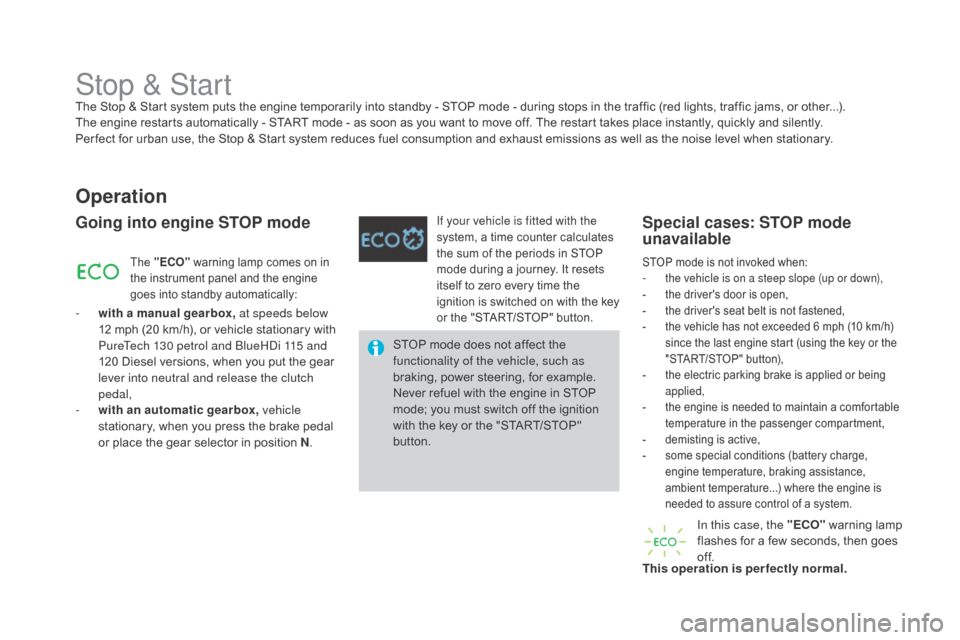
DS4_en_Chap08_conduite_ed03-2015
Stop & StartThe Stop & Start system puts the engine temporarily into standby - STOP mode - during stops in the traffic (red lights, traffic jams, or other...).
T he engine restarts automatically - START mode - as soon as you want to move off. The restart takes place instantly, quickly and silently.
Per fect for urban use, the Stop & Start system reduces fuel consumption and exhaust emissions as well as the noise level when stationary.
Operation
Going into engine STOP mode
STOP mode does not affect the
functionality of the vehicle, such as
braking, power steering, for example.
Never refuel with the engine in STOP
mode; you must switch off the ignition
with the key or the "START/STOP"
button.
The "ECO" warning lamp comes on in
the instrument panel and the engine
goes into standby automatically:
- with a manual gearbox, at speeds below 12 mph (20 km/h), or vehicle stationary with
PureTech 130 petrol and BlueHDi 115 and
120 Diesel versions, when you put the gear
lever into neutral and release the clutch
pedal,
-
w
ith an automatic gearbox, vehicle
stationary, when you press the brake pedal
or place the gear selector in position N .
If your vehicle is fitted with the
system, a time counter calculates
the sum of the periods in STOP
mode during a journey. It resets
itself to zero every time the
ignition is switched on with the key
or the "START/STOP" button.
STOP mode is not invoked when:
-
t he vehicle is on a steep slope (up or down),
-
t
he driver's door is open,
-
t
he driver's seat belt is not fastened,
-
t
he vehicle has not exceeded 6 mph (10 km/h)
since the last engine start (using the key or the
"START/STOP" button),
-
t
he electric parking brake is applied or being
applied,
-
t
he engine is needed to maintain a comfortable
temperature in the passenger compartment,
-
d
emisting is active,
-
s
ome special conditions (battery charge,
engine temperature, braking assistance,
ambient temperature...) where the engine is
needed to assure control of a system.
Special cases: STOP mode
unavailable
In this case, the "ECO" warning lamp
flashes for a few seconds, then goes
of f.
This operation is perfectly normal.
Page 216 of 436
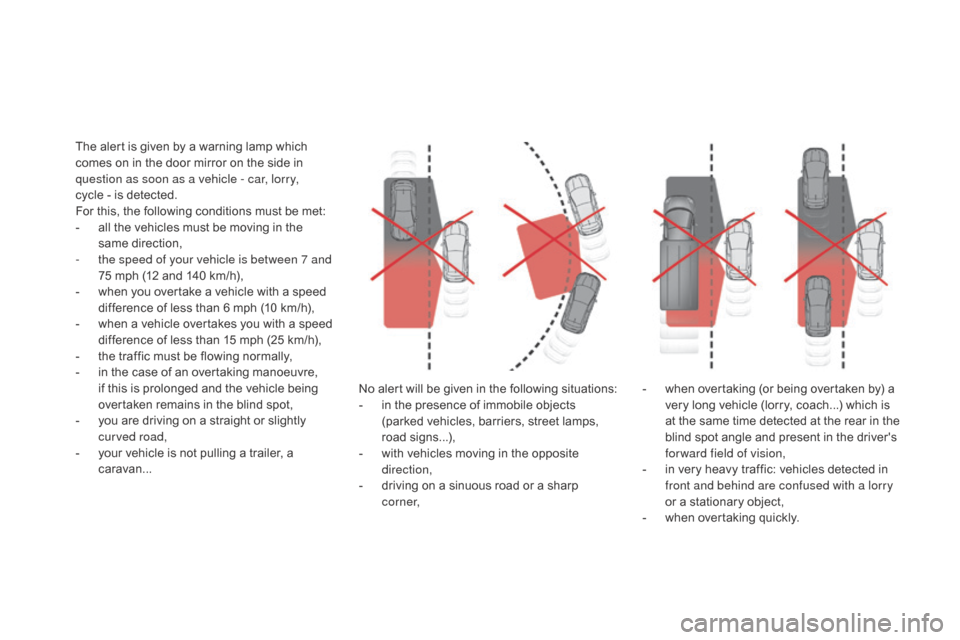
DS4_en_Chap08_conduite_ed03-2015
No alert will be given in the following situations:
- i n the presence of immobile objects
(parked vehicles, barriers, street lamps,
road signs...),
-
w
ith vehicles moving in the opposite
direction,
-
d
riving on a sinuous road or a sharp
c o r n e r,
The alert is given by a warning lamp which
comes on in the door mirror on the side in
question as soon as a vehicle - car, lorry,
cycle
- is detected.
For this, the following conditions must be met:
-
a
ll the vehicles must be moving in the
same direction,
-
t
he speed of your vehicle is between 7 and
75 mph (12 and 140 km/h),
-
w
hen you overtake a vehicle with a speed
difference of less than 6 mph (10 km/h),
-
w
hen a vehicle overtakes you with a speed
difference of less than 15 mph (25 km/h),
-
t
he traffic must be flowing normally,
-
i
n the case of an overtaking manoeuvre,
if this is prolonged and the vehicle being
overtaken remains in the blind spot,
-
y
ou are driving on a straight or slightly
curved road,
-
y
our vehicle is not pulling a trailer, a
caravan... -
w hen overtaking (or being overtaken by) a
very long vehicle (lorry, coach...) which is
at the same time detected at the rear in the
blind spot angle and present in the driver's
forward field of vision,
-
i
n very heavy traffic: vehicles detected in
front and behind are confused with a lorry
or a stationary object,
-
w
hen overtaking quickly.
Page 310 of 436
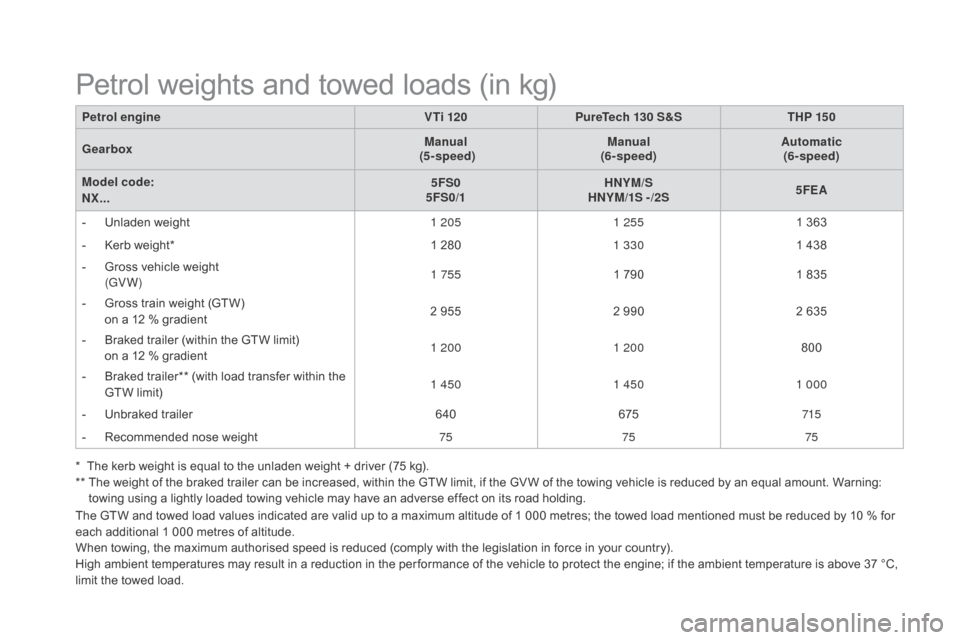
DS4_en_Chap11_caracteristiques_ed03-2015
The GTW and towed load values indicated are valid up to a maximum altitude of 1 000 metres; the towed load mentioned must be reduced by 10 % for
each additional 1 000 metres of altitude.
When towing, the maximum authorised speed is reduced (comply with the legislation in force in your country).
High ambient temperatures may result in a reduction in the per formance of the vehicle to protect the engine; if the ambient temperature is above 37 °C,
limit the towed load.
Petrol weights and towed loads (in kg)
Petrol engineV Ti 120PureTech 130 S&S THP 15 0
Gearbox Manual
(5 - speed) Manual
(6- speed) Automatic
(6- speed)
Model code:
NX... 5FS0
5FS0/1 HNYM/S
HNYM/1S - /2S 5FEA
-
U
nladen weight 1 2051 2551 363
-
K
erb weight* 1 2801 330 1 438
-
G
ross vehicle weight
(GV W) 1 755
1 790 1 835
-
G
ross train weight (GTW)
o
n a 12 % gradient 2 955
2 990 2 635
-
B
raked trailer (within the GTW limit)
o
n a 12 % gradient 1 200
1 200 800
-
B
raked trailer** (with load transfer within the
GTW limit) 1 450
1 4501 000
-
U
nbraked trailer 640675715
-
R
ecommended nose weight 757575
*
T
he kerb weight is equal to the unladen weight + driver (75 kg).
**
T
he weight of the braked trailer can be increased, within the GTW limit, if the GV W of the towing vehicle is reduced by an equal amount. Warning:
towing using a lightly loaded towing vehicle may have an adverse effect on its road holding.
Page 311 of 436
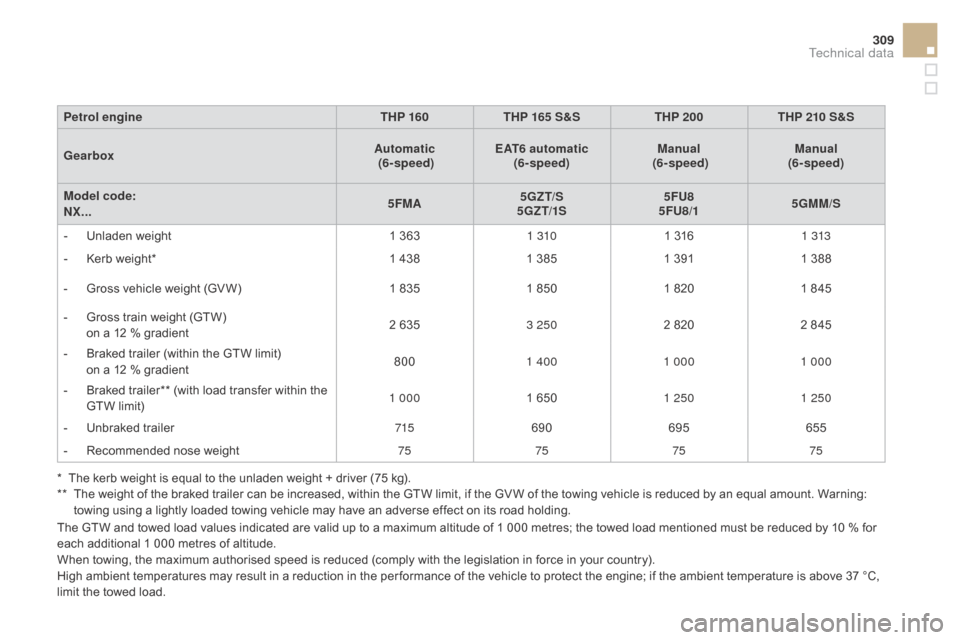
309
DS4_en_Chap11_caracteristiques_ed03-2015
Petrol engineTHP 160THP 165 S&S THP 200THP 210 S&S
Gearbox Automatic
(6- speed) EAT6 automatic
(6- speed) Manual
(6- speed) Manual
(6- speed)
Model code:
NX... 5FMA
5GZT/S
5GZ T/1S 5FU8
5FU8/1 5GMM/S
-
U
nladen weight 1 3631 3101 316 1 313
-
K
erb weight* 1 4381 385 1 3911 388
-
G
ross vehicle weight (GV W) 1 8351 850 1 8201 845
-
G
ross train weight (GTW)
o
n a 12 % gradient 2 635
3 2502 8202 845
-
B
raked trailer (within the GTW limit)
o
n a 12 % gradient 800
1 400 1 000 1 000
-
B
raked trailer** (with load transfer within the
GTW limit) 1 000
1 6501 2501 250
-
U
nbraked trailer 715690 695655
-
R
ecommended nose weight 75757575
The GTW and towed load values indicated are valid up to a maximum altitude of 1 000 metres; the towed load mentioned must be reduced by 10 % for
each additional 1 000 metres of altitude.
When towing, the maximum authorised speed is reduced (comply with the legislation in force in your country).
High ambient temperatures may result in a reduction in the per formance of the vehicle to protect the engine; if the ambient temperature is above 37 °C,
limit the towed load. * The kerb weight is equal to the unladen weight + driver (75 kg).
**
T
he weight of the braked trailer can be increased, within the GTW limit, if the GV W of the towing vehicle is reduced by an equal amount. Warning:
towing using a lightly loaded towing vehicle may have an adverse effect on its road holding.
Technical data
Page 314 of 436
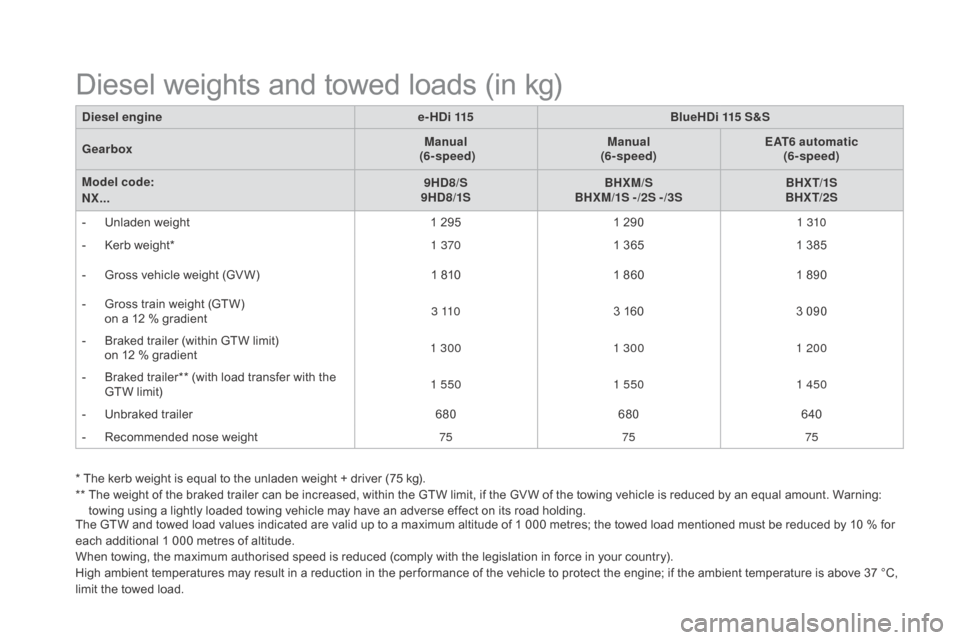
DS4_en_Chap11_caracteristiques_ed03-2015
diesel enginee-H d i 115BlueH d i 115 S&S
Gearbox Manual
(6- speed) Manual
(6- speed) EAT6 automatic
(6- speed)
Model code:
NX... 9H
d8
/S
9H
d8
/1SBHXM/S
BHXM/1S -/2S -/3S BHX T/1S
BHX T/2S
-
U
nladen weight 1 2951 290 1 310
-
K
erb weight* 1 3701 365 1 385
-
G
ross vehicle weight (GV W) 1 8101 860 1 890
-
G
ross train weight (GTW)
o
n a 12 % gradient 3 11 0
3 160 3 090
-
B
raked trailer (within GTW limit)
o
n 12 % gradient 1 300
1 300 1 200
-
B
raked trailer** (with load transfer with the
GTW limit) 1 550
1 550 1 450
-
U
nbraked trailer 680680640
-
R
ecommended nose weight 757575
Diesel weights and towed loads (in kg)
The GTW and towed load values indicated are valid up to a maximum altitude of 1 000 metres; the towed load mentioned must be reduced by 10 % for
each additional 1 000 metres of altitude.
When towing, the maximum authorised speed is reduced (comply with the legislation in force in your country).
High ambient temperatures may result in a reduction in the per formance of the vehicle to protect the engine; if the ambient temperature is above 37 °C,
limit the towed load. * The kerb weight is equal to the unladen weight + driver (75 kg).
**
T
he weight of the braked trailer can be increased, within the GTW limit, if the GV W of the towing vehicle is reduced by an equal amount. Warning:
towing using a lightly loaded towing vehicle may have an adverse effect on its road holding.
Page 315 of 436
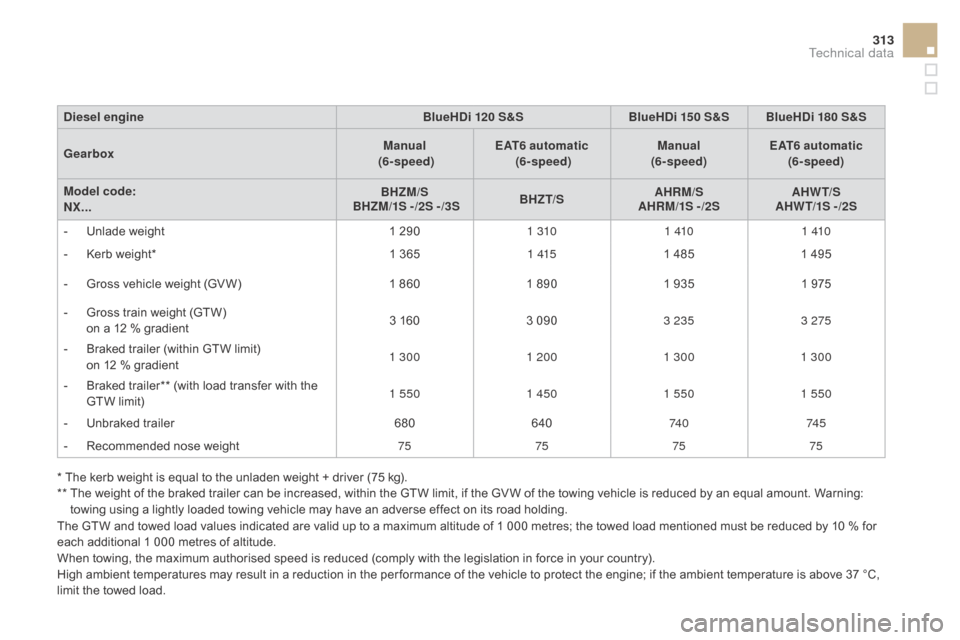
313
DS4_en_Chap11_caracteristiques_ed03-2015
diesel engineBlueH d i 120 S&S BlueH d i 150 S&S BlueH d i 180 S&S
Gearbox Manual
(6- speed) EAT6 automatic
(6- speed) Manual
(6- speed) EAT6 automatic
(6- speed)
Model code:
NX... BHZM/S
BHZM/1S -/2S -/3S BHZT/SAHRM/S
AHRM/1S -/2S AHW T/S
AHW T/1S - /2S
-
U
nlade weight 1 2901 3101 4101 410
-
K
erb weight* 1 3651 4151 485 1 495
-
G
ross vehicle weight (GV W) 1 8601 890 1 935 1 975
-
G
ross train weight (GTW)
o
n a 12 % gradient 3 160
3 090 3 235 3 275
-
B
raked trailer (within GTW limit)
o
n 12 % gradient 1 300
1 2001 300 1 300
-
B
raked trailer** (with load transfer with the
GTW limit) 1 550
1 4501 550 1 550
-
U
nbraked trailer 680640 74 074 5
-
R
ecommended nose weight 75757575
The GTW and towed load values indicated are valid up to a maximum altitude of 1 000 metres; the towed load mentioned must be reduced by 10 % for
each additional 1 000 metres of altitude.
When towing, the maximum authorised speed is reduced (comply with the legislation in force in your country).
High ambient temperatures may result in a reduction in the per formance of the vehicle to protect the engine; if the ambient temperature is above 37 °C,
limit the towed load. * The kerb weight is equal to the unladen weight + driver (75 kg).
**
T
he weight of the braked trailer can be increased, within the GTW limit, if the GV W of the towing vehicle is reduced by an equal amount. Warning:
towing using a lightly loaded towing vehicle may have an adverse effect on its road holding.
Technical data